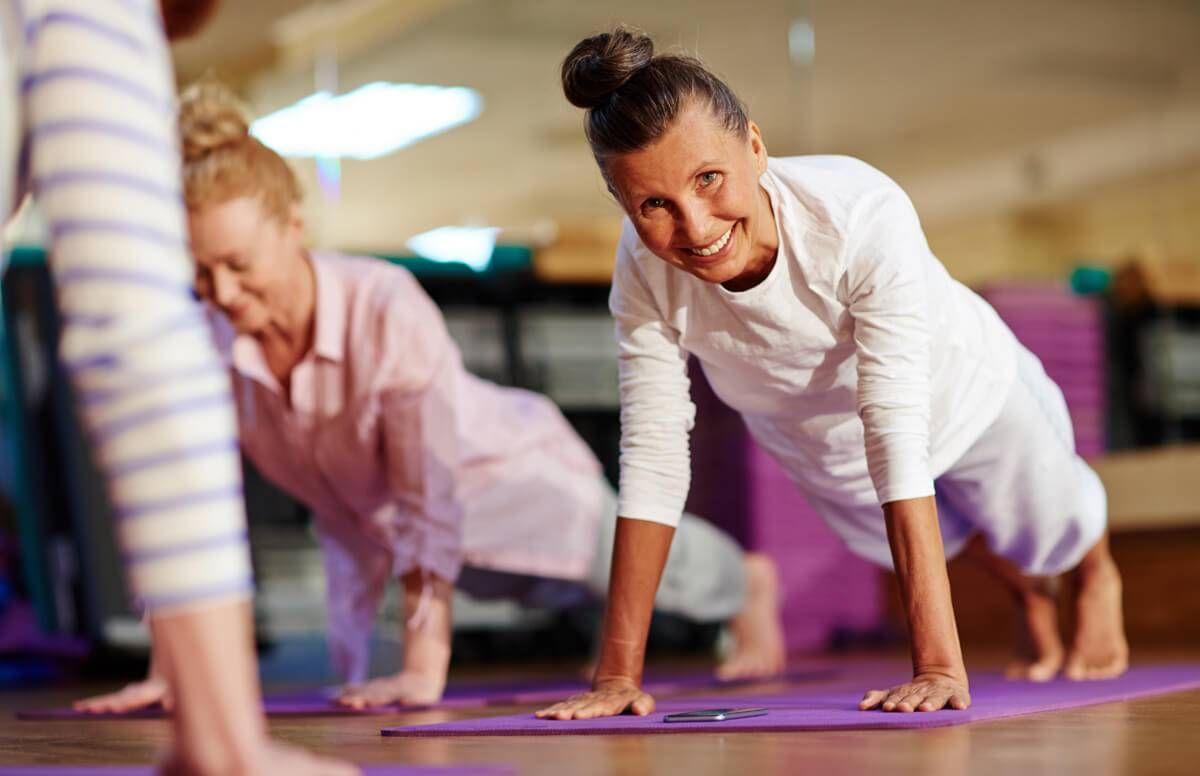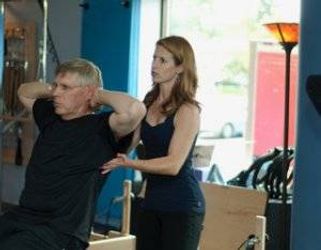Benefits of Pilates: Strength and Stability
Learn what it is, and how to find the right class and instructor for you
Tiza Riley’s client has spinal stenosis, severe osteoporosis and a rotator cuff injury that was never repaired. Still, at 82, her client has never felt better. She does Pilates (pronounced pih-LA-tays), the increasingly popular exercise system for women and men.

“I’ve been working with her for 10 years,” says Riley, a master trainer at CORE Conditioning in Studio City, Calif. “She’s limited in what she can do. There are activities she has to avoid completely. But today, she can do so much without pain.”
Like driving to Palm Springs twice a year to see her son — without back pain. And gardening four days a week. During their sessions, Riley works on her client’s core stability on a floor mat, then moves to a piece of Pilates equipment called the Reformer to strengthen her client’s feet and legs.
Pilates Works the Whole Body
Core strength and stability are at the center of Pilates, which works the whole body to improve posture, balance, flexibility and strength. The core, Riley explains, is comprised of the pelvic floor, transverse abdominis, diaphragm and multifidi along the spine, which, when properly engaged, work together to create the effect of a nice snug corset.

“The core holds up your spine,” Riley explains. “On top is the weight of your head, shoulder girdle and upper body. Then, you need to have mobility in your legs. In Pilates, we bring the top and bottom together through the core. If your core is weak, your upper body is not supported, your spine starts to shrink and hunch, and that affects your gait. As we get older, keeping the right posture through proper core engagement makes all the difference in quality of life.”
As Joseph Pilates, creator of the exercise system, famously said, “If your spine is stiff at 30, you are old. If it is flexible at 60, you are young.”
Pilates’ Beginnings
Originally from Mönchengladbach, Germany, Pilates developed the exercise system during World War I, while he was being held at the Knockaloe internment camp on the Isle of Man. He developed a series of floor exercises on a mat that engage and strengthen the core, stabilize the pelvis, strengthen the arms and legs and lengthen and mobilize the spine.
Working with his fellow internees, including some who were bedridden, he innovated a series of straps and pulleys that would support the body while doing the exercises. After the war, Pilates moved to New York City with his wife and formalized the exercise system he had created, which he called “Contrology.”
He also developed the strap-and-pulley system into equipment designed to help accelerate the process of stretching, strengthening, body alignment and increased core strength started by the mat work. The Reformer is the best-known and most popular of this equipment; it "includes a moving platform that inherently challenges stability and balance,” Riley says.
The Reformer also supports the body during Pilates.
“For people over 50, mat Pilates can be stressful on the neck and shoulders,” Riley notes. “Joe did the mat work first, then created the equipment to help people who needed more support while doing the work. The Reformer gives you something to push against, whereas on the mat you’re pulling against gravity.”
Mental and Physical Benefits of Pilates
The benefits of Pilates are not only physical, but mental. “The Reformer gives the body more input and feedback that the nervous and neurological systems need to wake up and become active,” says Cari Riis Stemmler, owner and master teacher at Paragon Pilates & Physical Therapy in Edina, Minn.
“Pilates, whether on the mat or on a piece of equipment, requires precision and focus," she says. "Pilates requires you to move in intricate ways, which helps with brain activity and mental acuity. We joke all the time that you’re getting smarter when you do Pilates, because you’re learning new things. It refreshes you mentally.”
Other benefits from a regular Pilates practice include arm and leg strength, balanced muscle development, injury prevention and “increased energy and joy for your activities,” Riis Stemmler says. Runners, golfers, swimmers, runners, dancers and horseback riders all benefit from Pilates — so do people who aren’t as fit, or who come to Pilates with injuries or a chronic disease.
“The over-50 demographic is such a diverse group in the twenty first century, from the very fit to the post-surgical, from the sedentary to those with a condition like Parkinson’s,” Riis Stemmler says. “They also come to us with ankle sprains, meniscus tears and joint-related injuries.”
An acute injury should always be treated by a physician, then followed up with physical therapy. After that, Pilates can help with further rehabilitation and strength building.
“A well-trained, certified and experienced teacher will work with a client on the whole body,” Riis Stemmler adds. “With any injury or condition, the body adapts and creates compensatory patterns. As you’re healing, a good teacher will address the whole body and those compensatory patterns so the body is balanced as part of your recovery.”
Finding the Right Pilates Instructor
Today, Pilates is taught and practiced in a variety of styles, from the classical method Joseph Pilates devised to more contemporary iterations, including Stott Pilates, Balanced Body, Peak Pilates and even a new franchise on the scene: Club Pilates.
To find the right teacher, start by visiting the website of the Pilates Method Alliance (PMA), the nonprofit professional association dedicated to the field, and search the directory for an instructor in your area. Check out instructors’ certifications: In which style or program are they comprehensively certified, meaning, they can teach on all of the Pilates equipment? How many years of experience do they have?
Talk to friends and colleagues about instructors they like or who have helped them. When calling or emailing Pilates studios for information, advocate for yourself: Which instructors have experience with your concern, whether it’s a disk or joint injury, back issue or just wanting to improve your core strength and spine flexibility in a safe way? “If they say, ‘Oh, yes, we do that,’ and it feels more like a sales pitch than a conversation, you might want to look elsewhere,” advises Riis Stemmler.
If You Have Osteoporosis
If you have osteoporosis, many of the Pilates exercises are “contra-indicated,” meaning they could cause more harm than good. An instructor certified in a program like Rebekah Rotstein’s Buff Bones might be the ticket, as it combines bone-strengthening techniques with alignment and balance exercises. Ask if the studio also offers physical therapy, or receives referrals from physical therapists, which is an indication that the trainers can provide you with additional resources or instruction in addressing your physical concerns.
Finally, finding an instructor who feels right, someone who you can trust and connect with, is essential. Moreover, after taking a class, “Trust how your body feels. When you’re done with your workout, you should feel good. Worked, but supported and stronger,” Riley says.
When practiced safely and correctly, with an expert instructor, Pilates “is perfect form of exercise for people even into their 90s,” adds Riis Stemmler.

